Gas stations, train stations, and airports are oftentimes interchangeable places of mobility. They only relate to their own usefulness and are spatially disconnected. The French ethnologist and anthropologist Marc Augé coined the term ›non-places‹ for such monofunctional buildings: they have no history, identity, or connection to their surroundings.
An exception can be found on the still young federal motorway A71 near Sömmerda, where mobility meets archaeology, landscape design, and architectural culture. In close proximity to one of the most important archaeological sites from the early Bronze Age, the Leubinger Fürstenhügel, a pioneering service area was built. This is where a prince was buried in the originally about ten-meter-high burial mound some 4,000 years ago.
From 2010 to 2015, the A71 was built around the Fürstenhügel, leading from Schweinfurt across the Thuringian Forest and the state capital Erfurt, and on to Sangerhausen. In 2013, the Thuringian Ministry of Infrastructure and Agriculture commissioned the Deutsche Einheit Fernstraßenplanungs- und -bau GmbH, or DEGES, to search for an operator for the construction and operation of the planned service area. The special feature: The project should not be just another gas station, but within the framework of the IBA Thuringia and with a view to the region's unique cultural landscape, establish a connection to history, identity, and environment.
In 2014, an international competition was launched to initiate interdisciplinary planning for the design of the service station, which would integrate architecture, landscape architecture, and communication design. The goal was to embed the service station in the context of the gently rolling landscape and historical surroundings. The competition was a model process for the qualification of infrastructure measures. A young planning team from Berlin won the competition with a convincing design.
In September 2017, Shell Deutschland GmbH was awarded the contract to operate the service station and implemented the winning design from the interdisciplinary planning competition and recommendations from the IBA Thuringia. Shell commissioned the competition winners, MONO Architects, Planorama Landscape Architects, and MUS Studio, to carry out the execution planning for the service station, while DEGES was responsible for the exterior design on behalf of the federal and state governments. Construction of the service station began in October 2018, the official opening followed in 2021.
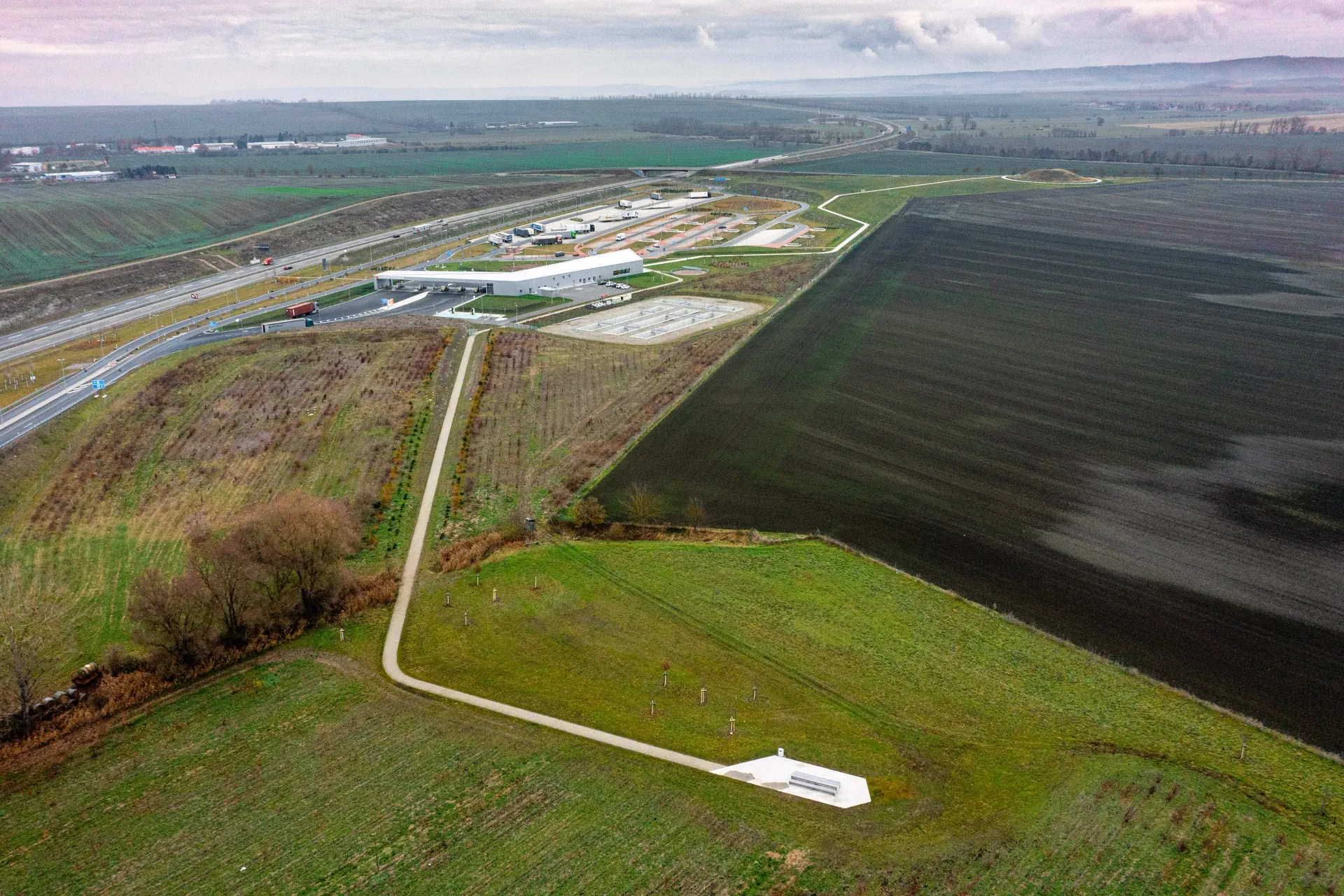 From the rest stop area on the A71, visitors can walk along a historic path to the archaeological highlight of the region, the Leubinger Fürstenhügel.
From the rest stop area on the A71, visitors can walk along a historic path to the archaeological highlight of the region, the Leubinger Fürstenhügel.
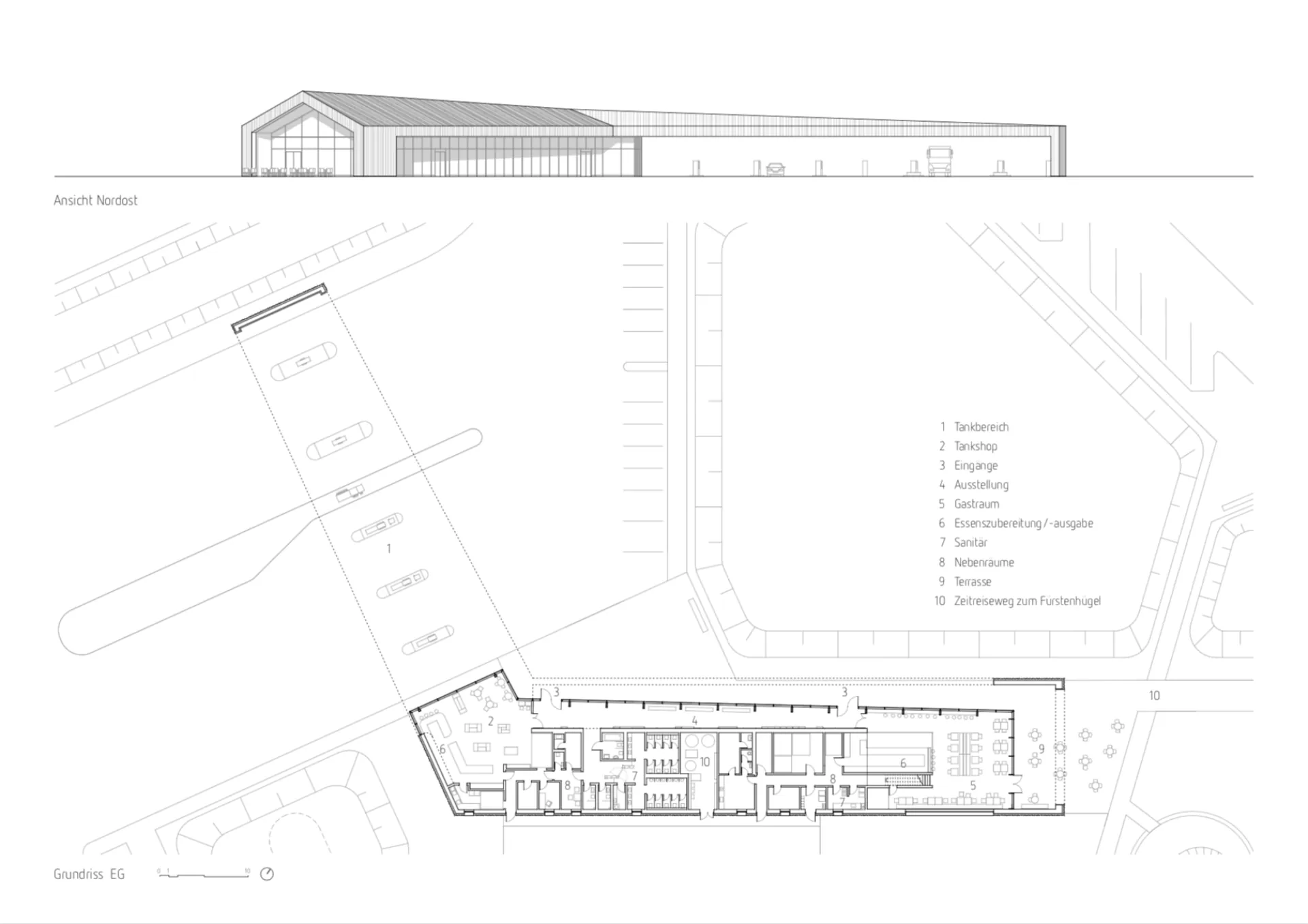 The building of the new rest area stretches out in a long angled shape that integrates into the surrounding landscape. The wing that is oriented orthogonally to the highway covers the functions of the gas station and serves as a large gate that marks the entrance to the rest area. The second wing bends towards the east, establishing a visual connection to the Leubinger Fürstenhügel. This is where all the functions of the rest stop are located. ©MONO Architects.
The building of the new rest area stretches out in a long angled shape that integrates into the surrounding landscape. The wing that is oriented orthogonally to the highway covers the functions of the gas station and serves as a large gate that marks the entrance to the rest area. The second wing bends towards the east, establishing a visual connection to the Leubinger Fürstenhügel. This is where all the functions of the rest stop are located. ©MONO Architects.
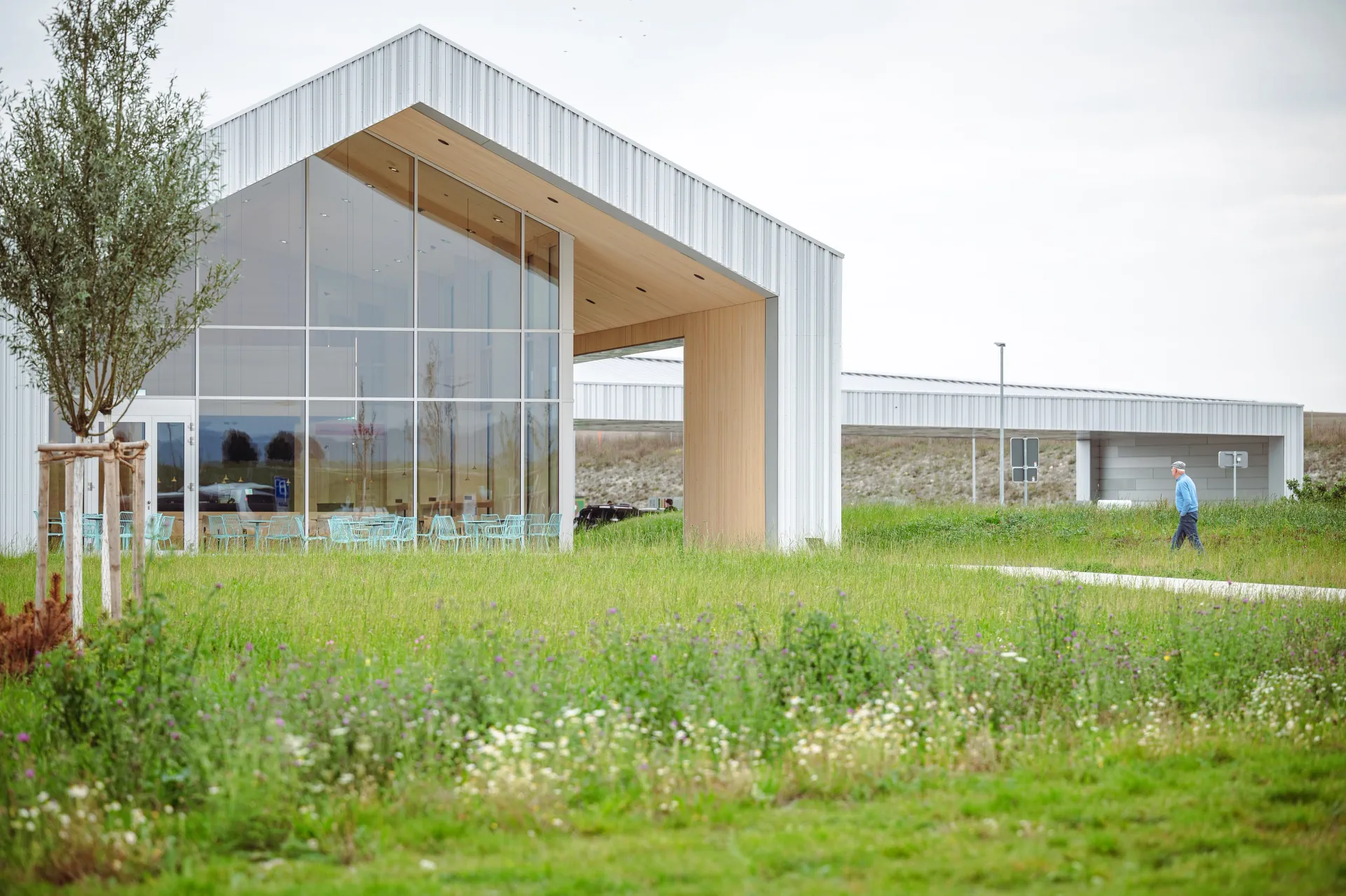 The project employs few, distinct design elements to convey a sense of calmness and provide a counterbalance to the fast-paced highway. Additionally, the facility aims to remain understated in relation to the historical Leubinger Fürstenhügel, the namesake and protagonist of this location.
The project employs few, distinct design elements to convey a sense of calmness and provide a counterbalance to the fast-paced highway. Additionally, the facility aims to remain understated in relation to the historical Leubinger Fürstenhügel, the namesake and protagonist of this location.
 The covered walkway plays a central role in the overall layout of the facility: it welcomes, protects, and guides travelers to all important public functions, such as the gas station and the rest area. A glass foyer is also connected to the walkway, serving as a central point of contact for visitors to obtain information about the Fürstenhügel. At the northeastern end, the covered walkway leads to a direct path through the landscape to the Fürstenhügel.
The covered walkway plays a central role in the overall layout of the facility: it welcomes, protects, and guides travelers to all important public functions, such as the gas station and the rest area. A glass foyer is also connected to the walkway, serving as a central point of contact for visitors to obtain information about the Fürstenhügel. At the northeastern end, the covered walkway leads to a direct path through the landscape to the Fürstenhügel.
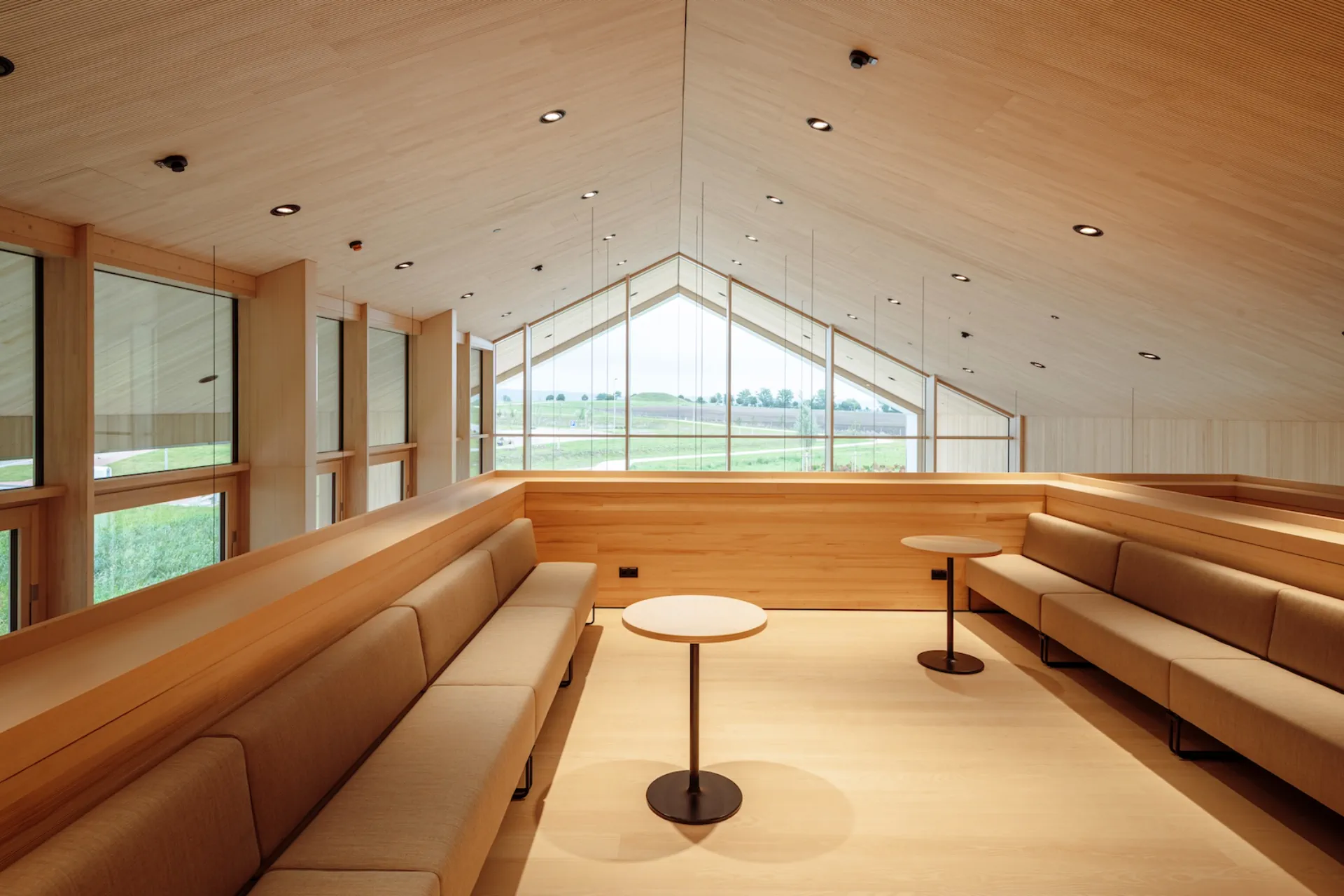 A large glazed gable end provides a view of the Fürstenhügel. The use of wood for the ceiling and walls in combination with carefully selected furniture has created a high quality of stay in a peaceful atmosphere for the restaurant area.
A large glazed gable end provides a view of the Fürstenhügel. The use of wood for the ceiling and walls in combination with carefully selected furniture has created a high quality of stay in a peaceful atmosphere for the restaurant area.
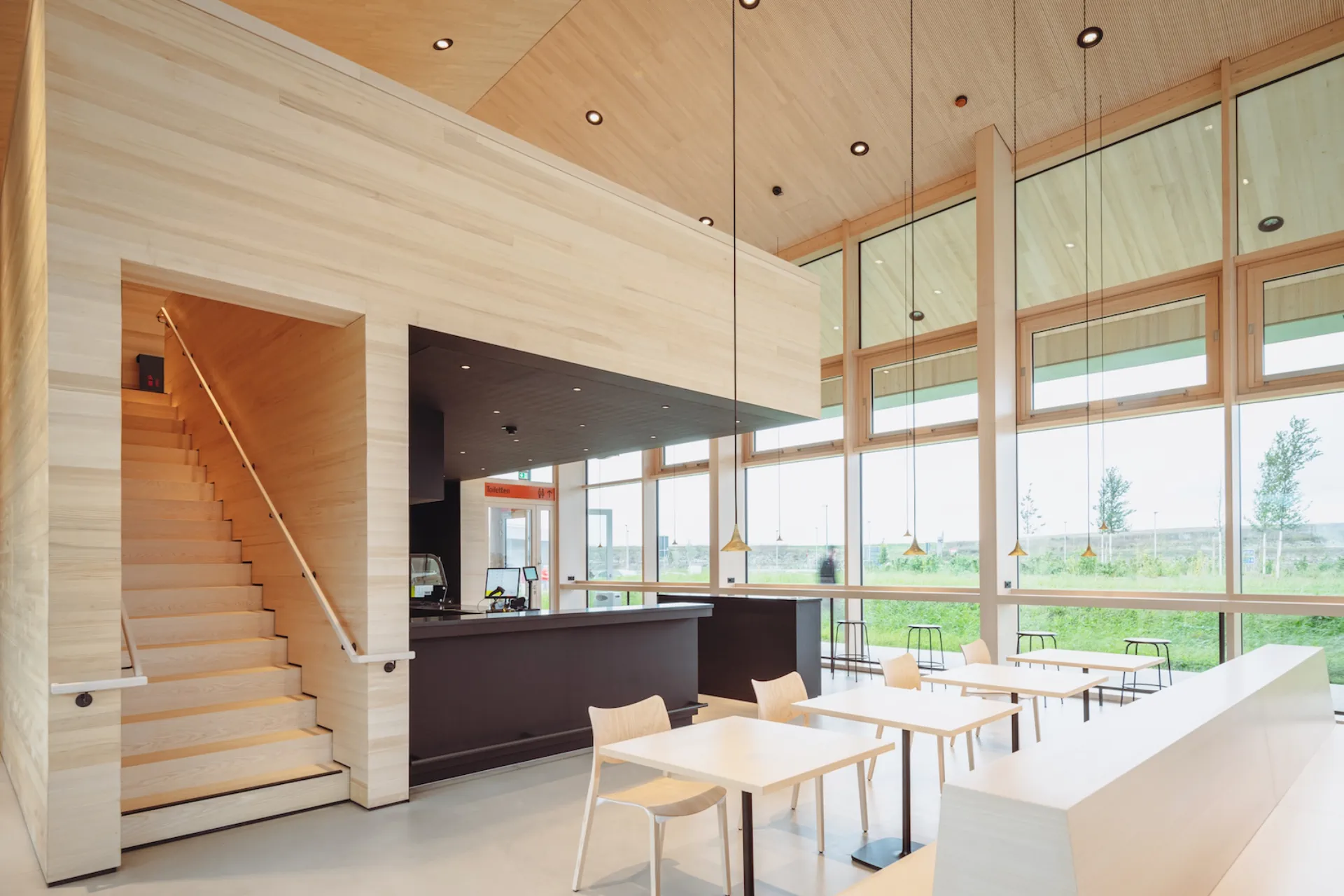 The dining area offers a variety of different retreat options, including seating islands, a counter, a lounge area on the gallery, and a playing corner for children.
The dining area offers a variety of different retreat options, including seating islands, a counter, a lounge area on the gallery, and a playing corner for children.
The new building and landscape architecture of the IBA project are characterized by a restrained aesthetic. On the one hand, to provide travelers with an atmosphere of calmness and rest. On the other hand, to take a back seat to the Fürstenhügel, the protagonist at this location. The typology of the Bronze Age longhouse served as a significant source of inspiration for the design of the flat, elongated building, which finds its design expression in the shape of the roof: The roof slowly rises from the fueling station to the ridge line and reaches its peak above the dining and gastronomy area at the eastern end, where a generous glass facade establishes a direct visual reference to the Fürstenhügel. A simple aluminum skin was used for the building envelope, underscoring the calm overall impression of the structure. Inside, the walls and ceilings covered in solid wood create a warm and friendly atmosphere.
On the north side, a covered pathway leads visitors to the two main entrances. These lead to the exhibition space, which serves as a foyer and distributor. A permanent exhibition about the Early Bronze Age culture occupies the large wooden wall in line with the building structure and continues outside as a nature trail. The exhibition thus connects architecture and landscape. Along historical events and archaeological finds, the path leads to the burial mound and finally encloses the real exhibit with a circular pathway structure. Bronze stelae and intarsia in the concrete stage the way there as a timeline and offer further information on the archaeological discoveries in the region and the milestones of history. Another special feature is the landscape terrace located in the opposite direction in the area of the compensation areas, which makes the emerging vegetation areas tangible and offers a resting place with a view of the facility and surroundings. Travelers can thus leave the actual rest stop area, which is unusual in Germany. However, the nearby Unstrut bike path allows cyclists and hikers to use the time travel path and gastronomy as well.
The Leubinger Fürstenhügel gas station and rest area invite you to linger, which is rarely characteristic of transit locations. This ensemble does not pass by the region, but goes straight into its history. At the height of Sömmerda, it is now possible to experience a rich cultural landscape on the A71.
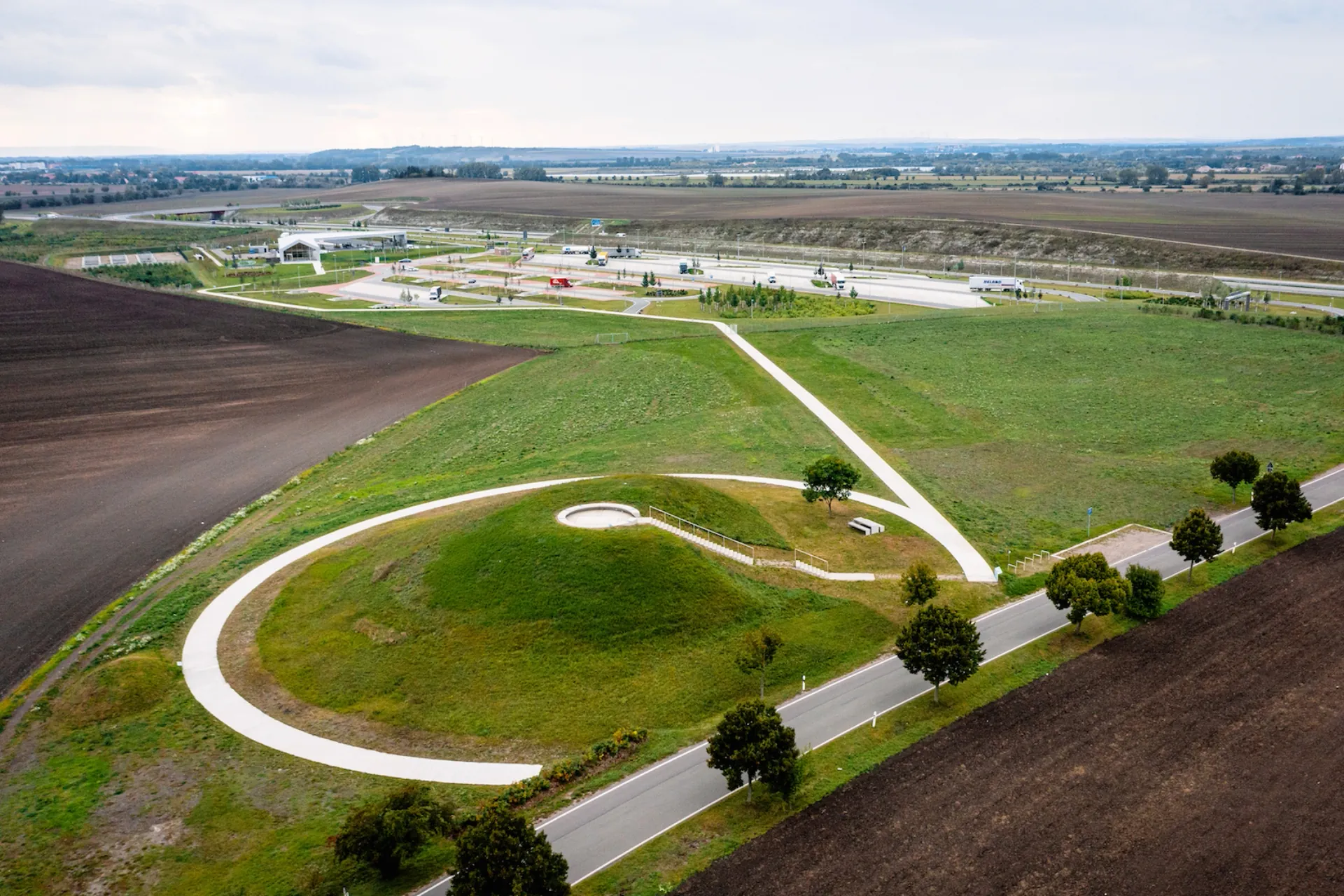 The approximately five hundred meter long path from the rest area building to the elevated landmark of Fürstenhügel is designed as an educational trail. The path itself is staged as a timeline built around historical events and outstanding archaeological finds.
The approximately five hundred meter long path from the rest area building to the elevated landmark of Fürstenhügel is designed as an educational trail. The path itself is staged as a timeline built around historical events and outstanding archaeological finds.
Location
Tank- und Rastanlage Leubinger Fürstenhügel
BAB71
99610 Sömmerda
Landscape Architecture
Planorama Landschaftsarchitektur, Berlin
Competition Support
PAD, Weimar
Planning and Superstructure Management for Concessionaire
KMP Bauplanungs- und Projektmanagement, Birkenwerder
Project Management for Concession Holder
Artelia, Hamburg
Awards
- Shortlist DAM-Preis 2023
- Shell Gold Retailer of the Year 2023
- Nominierung Deutscher Landschaftsarchitekturpreis 2023
- Anerkennungspreis Architektenkammer Thüringen 2022
IBA Project Manager
Ulrike Rothe
Downloads
Gespräch mit Britta Sauter_IBA Magazin 2022.pdf [pdf]
Projektprozess
Tank- und Rastanlage Leubinger Fürstenhügel im IBA Finale 2023
02.03.23
...
Shortlist DAM-Preis 2023
01.09.22
...
Anerkennungspreis der Architektenkammer Thüringen 2022
09.06.22
...
Feierliche Gesamtinbetriebnahme der Tank- und Rastanlage Leubinger Fürstenhügel
07.10.21
...
Tankanlage und Ausstellung in Betrieb genommen
31.03.21
...
Projektpartner besichtigen Tank- und Rastanlage bei Baustellenführung
30.06.20
...
Baubeginn für Autobahnraststätte
01.10.18
...
IBA Fachbeirat empfiehlt Projektstatus für Tank- und Rastanlage Leubinger Fürstenhügel
29.06.17
...
Startschuss für Konzessionsausschreibung Autobahnraststätte A 71 ‚Leubinger Fürstenhügel’
02.09.16
...
Tank- und Rastanlage ›Leubinger Fürstenhügel‹: Ausstellungseröffnung und Preisverleihung
15.06.15
...
Wettbewerb um Tank- und Rastanlage ›Leubinger Fürstenhügel‹ entschieden
06.05.15
...
Im Drupal zeigen